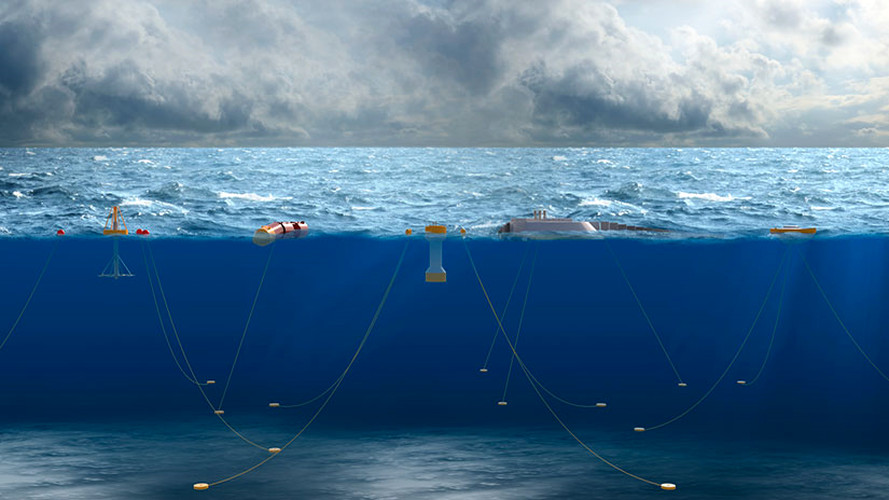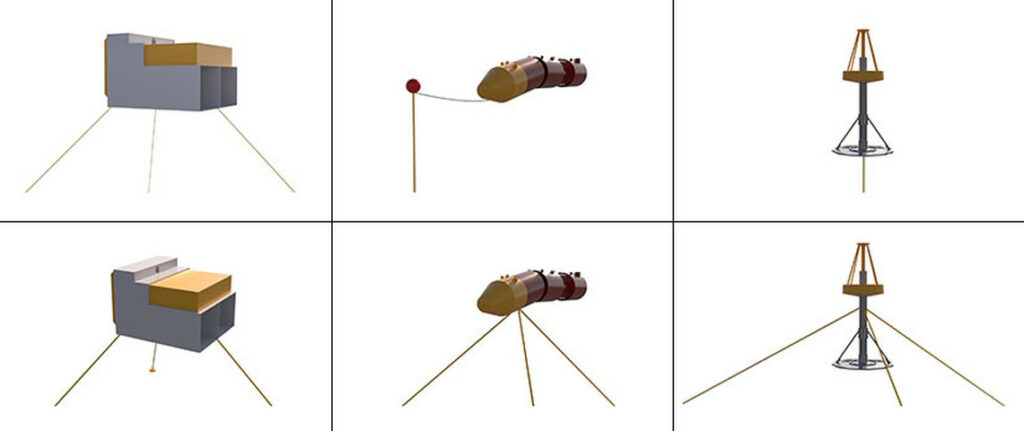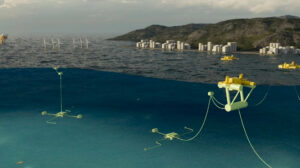Home Marine Energy Could PacWave test site potentially offer its own moorings for wave energy developers?
Researchers from the National Renewable Energy Laboratory (NREL) have identified the most cost-effective ways for the U.S. Department of Energy (DOE) to acquire mooring systems for PacWave – a new wave energy test site offshore Oregon – which could facilitate the test campaigns for developers.
 NREL’s researchers have determined cost-effective ways to purchase the moorings for a new wave energy test facility, currently under construction off the coast of Oregon (Courtesy of NREL/Illustration by Josh Bauer, NREL)
NREL’s researchers have determined cost-effective ways to purchase the moorings for a new wave energy test facility, currently under construction off the coast of Oregon (Courtesy of NREL/Illustration by Josh Bauer, NREL)
PacWave test site is set to test various sizes and shapes of wave energy converters (WECs) over the next couple of years, starting from 2025 – when it is expected that the site will open its berths to developers for the first time.
The facility has energetic waters, subsea power cables, and on-land infrastructure ready to use for WEC developers wanting to test their devices.
However, WEC developers do not always have mooring system components designed or acquired for device stationkeeping during testing, and PacWave does not own any such components for developers to use.
Therefore, commissioned by the U.S. DOE’s Department of Energy’s Water Power Technologies Office (WPTO), NREL’s researchers have published a report which addresses the challenge of determining the best method of acquiring mooring system components for WECs expected to be tested at PacWave.
The report – produced by Stein Housner, a naval architect and marine engineer at NREL, and Senu Sirnivas, a mechanical engineer at NREL – details the design process and potential acquisition costs of general mooring system components to be used at PacWave.
Using the results, it is initially recommended that the most cost-effective mooring acquisition scenario would be for PacWave to purchase and retain the mooring system components used for the first few devices that are tested at PacWave from the developers, rather than purchase a predetermined set of components, as outlined in this report.
This way, PacWave can slowly compile reliable and proven mooring system designs that can be reconfigured for future deployments.
The costs of different types of moorings for different wave energy devices deemed ‘a bargain’
 Although wave energy devices come in many shapes and sizes, most come in one of three ‘main’ types: oscillating water column (left), attenuator (middle), and point absorber (right). For their mooring study, the researchers identified generic systems that could serve all three. (Courtesy of NREL/Illustrations by Josh Bauer, NREL)
Although wave energy devices come in many shapes and sizes, most come in one of three ‘main’ types: oscillating water column (left), attenuator (middle), and point absorber (right). For their mooring study, the researchers identified generic systems that could serve all three. (Courtesy of NREL/Illustrations by Josh Bauer, NREL)
No two wave energy converters are the same. That means no single mooring system can serve every prototype that lands at PacWave. Some wave energy converters are as small as buoys. Others are as big as floatplanes designed to land on water and require more than one tether. And some need a tough chain while others perform better with a pliable rope that lets them bob in the waves.
If each company buys its own mooring system, customized to suit its bespoke design, that would be both expensive and inefficient, according to NREL.
“The mooring systems’ main goal is to keep the device where you want it and not let it float away or bump into anything else. The question was, would it be beneficial for PacWave to own mooring components or to have developers design and acquire them?”
“If a technology developer is only testing a device for a couple months, why spend all that money for just one test?” Housner said.
To tackle the issue, the co-authors of the study set out to determine what kind of generic mooring systems could get the job done and how much those systems might cost.
Housner and Sirnivas’ colleagues at the Pacific Northwest National Laboratory put together a list of all the potential wave energy devices that could be tested at PacWave.
Based on that, the team categorized the devices into three main types: point absorbers, attenuators, and oscillating water columns.
According to those three wave energy device types, Housner and Sirnivas devised a list of potential mooring systems that could work well for each. They came up with 43 different mooring designs that use different combinations of materials (like metal chain versus synthetic or wire rope), diameters, lengths, footprints, and more.
“Then the question was, how do we determine the total cost of buying mooring system components for PacWave?” Housner said. “Do we say – ‘Order five of these mooring lines from X company’ – and that’s all you need? How do you then select how many of each mooring system to acquire for devices that may or may not be tested at PacWave?”
Housner and Sirnivas considered how the already-established U.S. Navy Wave Energy Test Site (WETS) in Hawaii handled its mooring systems, which offers preinstalled systems, so developers can hook up their devices to the already existing system on site.
But leaving mooring systems submerged in salty, energetic waters can cause them to degrade quickly.
Instead, Sirnivas and Housner recommend that PacWave purchase mooring components and store them on shore. And to avoid buying systems for devices that may never show up, they also recommend the facility purchase mooring components that work for each device as they arrive.
When a device finishes its ocean trial, PacWave would then retain the mooring system components. Eventually, they could accrue a diverse enough set to serve almost any wave energy device.
Once Housner and Sirnivas identified the most practical way to purchase the mooring systems, they could finally track down the most cost-effective versions of those systems.
Based on those estimates, Housner said, if PacWave bought one mooring system for each of its four berths, that would likely cost around $2 million.
If the test site bought enough mooring systems to fit as many wave energy devices as the waters could hold, that might come to around $9 to $10 million, but the site does not need to do that – at least not yet, according to NREL.
Deeming the $2 million cost as a bargain, NREL said that it is up to WPTO and PacWave now to decide what to do with Housner and Sirnivas’ recommendations.
“I’m not surprised at those costs. The objective was to minimize the cost, and we did,” Housner concluded.
Worth noting, the U.S. DOE recently launched a $16.4 million funding call for marine energy and floating wind research. The funding opportunity covers the research into reliable moorings for floating offshore wind and marine energy systems, and will support six to eight projects with the total funding of $6.4 million.

Posted: 12 days ago
Subscribe and follow
Offshore Energy – Marine Energy LinkedIn

>>> Read full article>>>
Copyright for syndicated content belongs to the linked Source : OffshoreEnergy – https://www.offshore-energy.biz/could-pacwave-test-site-potentially-offer-its-own-moorings-for-wave-energy-developers/













![[News] Japan Develops 10nm Nanoimprint Technology, with Potential to Tackle EUV Bottleneck – TrendForce](https://earth-news.info/wp-content/uploads/2025/12/329851-news-japan-develops-10nm-nanoimprint-technology-with-potential-to-tackle-euv-bottleneck-trendforce-360x180.jpg)














![[News] Japan Develops 10nm Nanoimprint Technology, with Potential to Tackle EUV Bottleneck – TrendForce](https://earth-news.info/wp-content/uploads/2025/12/329851-news-japan-develops-10nm-nanoimprint-technology-with-potential-to-tackle-euv-bottleneck-trendforce-120x86.jpg)

